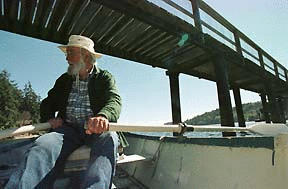Saying that the community values a relatively pristine Blakely Harbor, the Planning Commission Thursday unanimously recommended against two applications to build the first new docks in some 25 years.
One of the applications – from Kim and Sue Bottles of Seaborn Road on the north side of the harbor – received significant support from the neighbors, and had been recommended for approval by planning staff. But the commissioners believed broader issues were at stake.
“These are mere conveniences for the owners – the public doesn’t benefit,” said commissioner Tom Dreiling.
“Rejecting both of these applications essentially says there will be no more private docks on Blakely Harbor, a position with which I do not disagree,” said commissioner Charlie Averill.
Commissioner Michael Cox based his negative vote on what he saw as strong evidence of community-wide sentiment against the docks: a recommendation from an ad hoc advisory committee against any new private docks on Blakely Harbor, and a recent moratorium on new dock applications imposed by the City Council after the Hacker and Bottle applications were filed.
“Those actions speak to the values of the larger community,” Cox said.
The commission’s recommendation against approving permits for the docks will go to Planning Director Stephanie Warren, who will make the final decision. Warren’s decision could be appealed to the city hearing examiner.
Unwritten rules
The applications from the Bottles and from Robert and Joanne Hacker of Country Club Road on the south side of the harbor generated significant protests from area residents, who claimed that the applications breached an implied agreement among neighbors not to build new docks.
According to the city planning staff, there are four existing docks on the harbor – three on the north side and a community dock for the Country Club area on the south side.
Susan Bottles said that boating is an essential part of her family’s life, and that they made sure docks were a permitted use in Blakely Harbor before buying the Seaborn lot for a home site.
“The so-called agreement within Blakely Harbor for no new docks was never communicated to us,” she said.
The Bottles proposed a 100-foot low-profile floating structure with a 40-foot T end to access a power boat that Kim Bottles uses for his daily commute to Seattle. Bottles said the design was chosen after consultation with state marine ecology experts, who said the design was the most environmentally benign arrangement available.
They presently tie their boat to an offshore float, and row out to it in a dinghy.
While the low-impact design drew support from a number of neighbors and from the city staff, others were concerned about setting a precedent.
“Approval of either application would greatly complicate the ability of the city to turn down future applications,” said Ivar MacDougall, president of the South Bainbridge Community Association. “The choice is between the public use of public water and the private use of public water.”
There was no support for the application from the Hackers, particularly because the south shore recedes so shallowly that even the 211-foot dock the Hackers propose would still rest on the mud at low tide.
Cindy Stahl of Caicos Construction, representing the Hackers, who were not present, agreed that the Hackers would still moor their boat to the float, but said the dock would provide better access.
But most of those who testified at the hearing said access by dinghy is not enough of a hardship to justify a proliferation of new docks, which would disrupt both visual and water access.
“In an ideal world, I would like a dock too,” said Country Club drive resident Jim Smith. “But there is no real hardship in dragging a dinghy across the tidal flat and rowing out to our boats.”
And long-time harbor resident Robert Smith said the now-deceased former owners of the Hacker property would agree.
“If they were here, they would curl your hair with what they would say about a dock on that property,” Smith said.



